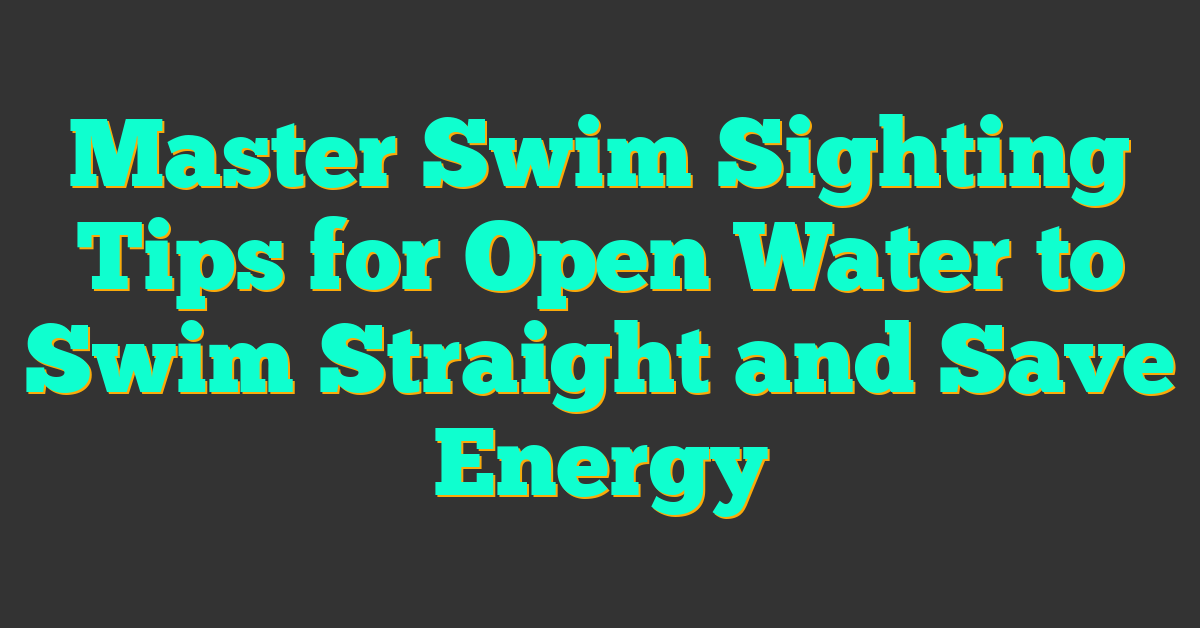Swimming in open water can be both thrilling and a bit intimidating. Unlike a pool, you don’t have walls or lanes to guide you, so staying on course is key. Over the years I’ve learned that mastering sighting techniques not only helps you swim straighter but also boosts your confidence out there.

Whether you’re training for a triathlon or just enjoying a lake swim, knowing how to spot landmarks or buoys quickly makes a huge difference. I’ll share some simple tips that have helped me keep my bearings without breaking my rhythm. With a little practice you’ll find yourself gliding through open water with ease and focus.
Importance of Swim Sighting in Open Water
Swim sighting plays a crucial role in open water swimming, especially in triathlons where maintaining a straight line saves energy and time. I emphasize sighting because even small course deviations add extra distance, which can cost valuable seconds or minutes. Staying on course reduces fatigue from unnecessary swimming and helps preserve strength for the bike and run that follow.
I find that confident sighting builds mental clarity during the swim. When I spot clear landmarks or buoys regularly, my rhythm stays steady, and I avoid panic or disorientation caused by drifting off track. Proper sighting creates a smooth flow from water to transition, which is vital for high-level racing.
I recommend practicing sighting during training swims in similar open water conditions. It conditions your eyes and body to react efficiently in real race scenarios, where sighting opportunities might be limited or obscured. Developing this skill helps maintain optimal navigation whether waves, glare, or choppy water challenge your view.
In triathlon coaching, I stress the connection between swim sighting, pacing, and energy management. Sighting correctly can significantly affect overall race performance, making it more than just a technique—it’s a competitive edge for every triathlete aiming to perform at their best.
Essential Swim Sighting Techniques
Mastering swim sighting gives triathletes a crucial edge in open water. It keeps you on track without wasting energy or losing momentum.
Lifting Your Head Without Losing Rhythm
Lifting your head disrupts stroke rhythm if done poorly. I lift my head smoothly and briefly, at the end of an exhale, to minimize drag and maintain body position. I practice bilaterally lifting—every three or five strokes—so it becomes second nature. Breathing to the side while glancing ahead helps me keep my cadence steady. If I lift too high or too long, I feel the slowdown immediately and adjust instantly.
Using Landmarks for Navigation
Using fixed landmarks like trees, buildings, or buoys keeps navigation clear and consistent. I pick visible, stable targets before the swim, choosing objects aligned with the course. I avoid distractions by focusing on larger, contrasting shapes rather than small or moving points. If landmarks become obscured, I switch to alternate points I scoped on the shore. Staying mentally anchored to these landmarks reduces doubt and keeps my sighting efficient throughout the swim.
Equipment That Helps With Swim Sighting
I rely on specific gear that sharpens swim sighting, boosting confidence and accuracy in open water. The right equipment reduces guesswork, helping me stay on course and maintain rhythm.
Polarized Goggles
Polarized goggles cut glare from the water surface, making landmarks and buoys clearer. I use them to spot distant targets with less eye strain during bright daylight. These goggles improve visual contrast and reduce reflections, which is crucial when spotting course markers against sunlight glare or choppy water. For early morning or cloudy swims, I switch to lighter tint but keep the polarization to maintain visibility. Investing in polarized swim goggles guarantees more precise sighting on race day.
Swim Caps with Bright Colors
Brightly colored swim caps enhance visibility from shore or kayak support, serving as reference points for sighting. I pick colors like neon yellow, orange, or hot pink that stand out against blue or green water. These caps make tracking my position easier when scanning for landmarks or buoys, especially in group swims or crowded races. Wearing a high-visibility cap also helps race officials and safety teams monitor my location. Choosing vibrant swim caps complements sighting techniques by keeping me visually anchored amid open water distractions.
Common Challenges and How to Overcome Them
Open water swim sighting comes with unique challenges that test a swimmer’s skills and mental focus. Understanding these challenges and applying strategic techniques helps maintain efficiency and confidence throughout the swim.
Dealing with Waves and Currents
Waves and currents disrupt balance and visibility, making sighting more difficult. I recommend timing your breath and sighting between waves to reduce drag and keep your head movement minimal. When currents push you off course, sight more frequently to correct your line without overcompensating, which wastes energy. Practicing in different water conditions trains your body to respond smoothly to these forces. To maintain stability, engage your core and keep a steady kick rhythm even in rough water, which improves body position and sighting effectiveness.
Visibility Issues in Different Weather Conditions
Visibility changes dramatically with weather and lighting, impacting your ability to spot landmarks or buoys. Overcast days or low light require picking larger, high-contrast targets that stand out against the background. When glare or bright sunlight impairs vision, polarized goggles become essential—they reduce reflections and enhance clarity. If fog or heavy rain limits sighting, increase the frequency of your lifts and use peripheral cues like shadows or water texture changes. Familiarizing yourself with the course before race day can also help memorize visual references, allowing you to rely less on momentary visibility and more on anticipation.
Training to Improve Open Water Sighting Skills
Improving open water sighting skills makes race day less stressful and boosts performance. Training with intention shapes your ability to spot targets confidently and stay on course.
Practicing in Pools and Controlled Environments
I recommend starting sighting practice in pools or calm water settings. Swim straight laps focusing on lifting your head just long enough to spot a fixed target at the pool’s edge. Keep your timing crisp to avoid disrupting your stroke rhythm. Use brightly colored cones or signs placed on the deck to mimic open water landmarks. Practicing bilateral sighting in this controlled environment helps develop muscle memory without the unpredictability of currents or waves.
Incorporating Sighting into Regular Swim Workouts
I advise adding sighting drills to your regular swim workouts to build consistency. For example, swim sets where every third or fifth stroke includes a quick sighting break train you to integrate this skill seamlessly. During group swims or intervals, practice lifting your head to spot buoys or landmarks placed along the lane or open water. Increasing frequency and precision of sighting during training prepares you for race conditions, reinforcing sighting as a natural part of your stroke rather than an interruption.
Training sighting skills throughout your swim preparation refines navigation instincts and improves efficiency, key to excelling in open water triathlon swims.
Conclusion
« Gear Organization Tips for Triathlon Prep: Stay Stress-Free and Race Ready
Open water swim sighting might seem tricky at first but with practice it becomes second nature. I’ve found that building confidence in my navigation skills not only saves energy but also makes the swim more enjoyable.
By focusing on simple techniques and using the right gear, you can stay on course and keep your rhythm steady. The key is to practice regularly in different conditions so you’re ready for whatever the water throws at you.
With patience and persistence, sighting will become a powerful tool in your open water swimming arsenal. It’s a game-changer that can boost both your performance and peace of mind out there.










